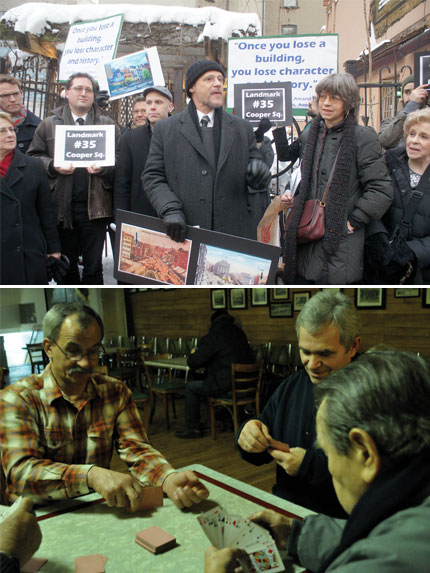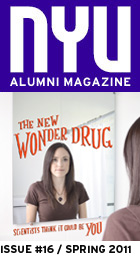new media
The Times Are A-Changing
NYU partners with the New York Times on an experimental neighborhood news site
by Kevin Fallon / CAS ’09
When graduate journalism student Suzanne Rozdeba (CAS ’01, GSAS ’12) met up with artist James De La Vega on St. Mark’s Place, he was leaning against the shuttered building that used to showcase his quirky street art: graffiti-style paintings often branded with the catchphrase Realiza Tu Sueño (Become Your Dream). As the two chatted, several neighbors interrupted to lament the closing and shake the hand of the area celebrity who could no longer afford to rent the space. It was an intimate neighborhood moment, easily lost to history without someone there to document it. And although only a student, Rozdeba reported this very local piece—alongside news about an East Village building fire, a fatal stabbing, and community reactions to service failures in the 2010 holiday blizzard—using an unusual introduction for someone in grad school: “I’m a reporter for a blog on The New York Times.”
Students from the Hyperlocal Newsroom class staff the Local East Village and produce content alongside neighborhood contributors.
Thanks to a new joint venture between the Times and NYU’s Arthur L. Carter Journalism Institute, a team of student reporters contributed to a news blog this year devoted entirely to Manhattan’s East Village. The site, called The Local East Village (LEV), is staffed by the Carter Institute’s Hyperlocal Newsroom class, which has students working alongside neighborhood contributors—local residents with no journalism background—to produce content. Times editors and developers troubleshoot, offer advice, and provide access to their wealth of databases and technological expertise. “It’s a teaching tool, a way to promote conversation, and it brings our neighbors in the community to the table,” says LEV editor Richard G. Jones, an award-winning former Times reporter and now NYU professor.
The site (www.eastvillage.thelocal.nytimes.com), which launched last September, draws upon additional student contributions from across NYU, including marketing consultants from the Leonard N. Stern School of Business, information technology consultants from the Courant Institute of Mathematical Sciences, and students in Tisch’s Interactive Telecommunications Program who are working with sensor technology to possibly monitor noise levels in the East Village—a major complaint in the neighborhood. The venture represents a necessary foray into community engagement using one of the industry’s most respected brands. For students now reporting with the promise of a Times byline, the effort brings a new dimension to the way journalism is taught. “They’re learning out loud,” explains Mary Ann Giordano, deputy Metro editor at the Times who also advises on the site.

top: East Village residents rally at 35 Cooper Square, a 185-year-old town house, to support its designation as an historic landmark. bottom: Members play cards at The Ukrainian Sports Club, soon to close due to rent hikes and dwindling membership.
In return, NYU students cover the East Village with a degree of footwork even the Times doesn’t possess, a change that follows an industrywide trend. Sites such as Examiner.com and Patch.com have become explosively popular and notable for their focus on very local news. The Times recognized this hunger and last year began covering the Fort Greene and Clinton Hill areas of Brooklyn in collaboration with the CUNY Graduate School of Journalism. Stopping short of acknowledging a “hyperlocal revolution,” Giordano admits that the Times had an urgent need to be part of the conversation: “We live in a Wiki world and reader engagement is becoming huge.” Still, like most other aspects of the changing media industry, there remains no solid business model for making hyperlocal news sites profitable and Giordano believes the assumption that millions of advertising dollars can be had in these ventures is misleading.
One way to keep costs down is to employ a “virtual assignment desk,” which provides an editorial work-flow system for assigning stories and for receiving and managing ideas, tips, and finished work from community and student contributors. Any registered user of nytimes.com can go to a special page to see what assignments are available. In fact, community members are encouraged not only to pitch ideas for stories, but also to write them. Jones, who edits these posts as stringently as he does his students’, says that the eventual goal is for community collaborators to produce 50 percent of the site’s content. Thus, LEV offers valuable lessons to students who are learning this new business from the ground up, and it helps the Times, which may apply aspects of the LEV model across the country—and even around the world. “If the open-source assignment desk works in the East Village,” explains Jay Rosen, associate professor at the Carter Institute, “it can work in Grand Rapids, Michigan, too.”
Young reporters cover the East Village with a degree of footwork even the Times doesn’t possess, a change that follows an industrywide trend.







